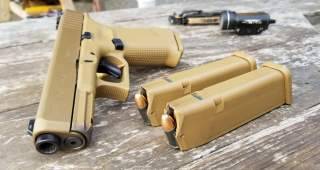You're Toast: 5 Ways A Bulletproof Vest Can Be Defeated
Scary, but reality.
Body armor protects against kinetic energy weapons that seek to deliver fatal wounds against friendly troops. Body armor can also be a Maginot Line, bypassed and made irrelevant. Artillery, including howitzers and mortars, and improvised explosive devices could batter troops wearing body armor.
For decades, protection lagged far behind lethality on the battlefield. The only practical protection from bullets and dangerous flying objects was steel, but weight forced a tradeoff between protection and mobility; adequate protection could render a soldier perfectly immobile. A compromise of equipping a soldier with enough steel to stop light shrapnel, ricochets and other flying objects—but not actual bullets—held from World War I to just after the Vietnam War.
Over the last forty years, scientists and engineers have made tremendous strides in the field of body armor. The most important innovation in body armor has been the invention of Kevlar, an extremely tough synthetic fiber developed by DuPont. Kevlar has been improved and otherwise refined to the point that it is now capable of stopping large-caliber handgun bullets. Other armor types include ceramic body armor and ultra-high density polyethylene, or plastic capable of stopping bullets up to armor-piercing .30-06 rifle rounds.
Like any measure on the battlefield, there is always a countermeasure. Most major armed forces are working to defeat contemporary body armors while increasing their own levels of protection. Here are five ways a bullet-proof vest could meet its match.
Recommended: The Fatal Flaw That Could Take Down an F-22 or F-35.
Recommended: Smith & Wesson's .44 Magnum Revolver: Why You Should Fear the 'Dirty Harry' Gun.
Recommended: 5 Best Shotguns in the World (Winchester, Remington and Beretta Make the Cut).
Bigger Bullets
At some point all body armor fails to protect a target from a sufficiently large (and powerful) round. Generally speaking, a larger bullet transfers more energy to the target. Today’s military ballistic helmets are rated to stop large-caliber pistol rounds and shrapnel but are unable to stop rifle rounds—a helmet capable of stopping rifle rounds would be too heavy and uncomfortable. The easiest way to overmatch a helmet rated to stop 9mm ammunition (typically 330 or more foot pounds of energy) is to target it with a 5.56mm carbine round (1,300 foot pounds of energy.)
Armor-piercing Bullets
The most obvious way to penetrate bullet proof armor is to field armor piercing bullets. The U.S. Army, concerned that current 5.56mm ammunition is insufficient to pierce body armor at combat ranges, has invented the XM1158 7.62mm Advanced Armor Piercing (ADVAP) round. ADVAP penetrates armor by using a heavy tungsten core penetrator. The combination of weight and velocity—and ideally a dart-like tip—could penetrate the weave of Kevlar and enable the round to defeat other armors, including steel. The XM1158 as envisioned would be issued to soldiers carrying M240 machine guns and larger battle rifles that would replace M4A1 carbines in select frontline units.
Flechettes
In the late 1960s, American defense contractors worked on a radical new small arms weapon system designed to penetrate body armor. The Special Purpose Individual Weapon (SPIW) fired metal darts instead of bullets. These darts could travel at a high rate of speed and punch through body armor to kill or injure enemy troops. Unfortunately, SPIW was plagued with technical problems and could never match traditional rifles on a cost basis. Even worse, metal darts provided inferior at causing body trauma: traditional bullets would ideally break apart or tumble soon after entering the human body, causing a wide wound channel. Darts would merely pass through the enemy, causing injuries but none as severe as real bullets.
Explosions and Concussive Force
Body armor protects against kinetic energy weapons that seek to deliver fatal wounds against friendly troops. Body armor can also be a Maginot Line, bypassed and made irrelevant. Artillery, including howitzers and mortars, and improvised explosive devices could batter troops wearing body armor. Recoilless rifles and man-portable rocket launchers can achieve similar effects, particularly with high explosive and thermobaric warheads. Although armor may stop shrapnel, most armor protection lacks coverage for the face, arms, legs and below the waist. The concussive force of explosions can also damage unprotected limbs, create traumatic brain injuries and cause internal injuries—even behind body armors.
Lasers
A technological wild card is the use of lasers to penetrate body armor. A short, intense pulse of focused light, lasers can burn through most objects, though their penetration abilities are greatly dependent on power, duration and local atmospheric conditions. Shortcomings in power storage and generation technology make it unlikely we’ll see laser pistols, carbines, and light machine guns anytime soon, but vehicle mounted lasers are already seeing deployment at a limited scale. Although lasers could probably burn through most body armor fairly easily they would have a problem similar to that of flechettes: a laser would only create a wound channel the same diameter as the beam itself.
Kyle Mizokami is a defense and national-security writer based in San Francisco who has appeared in the Diplomat, Foreign Policy, War is Boring and the Daily Beast. In 2009, he cofounded the defense and security blog Japan Security Watch. You can follow him on Twitter: @KyleMizokami.
Image: Reddit.
(This article first appeared last year.)

